Analysis of production, consumption and environmental burden of plastic industry in Vietnam by input-Output table
The plastic industry is an economic sector that plays an important role in promoting a circular economy in Vietnam.
This study used the updated 2018 input-output (IO) table to identify and analyse the production and consumption
of seven different plastics including: HDPE, PS, PE, PET, PVC, PP, and others. The study also integrated the IO
model to unveil the environmental burden of these plastics through the plastic demand of 40 economic sectors and
households. As a result, in 2018, the amount of direct solid waste from the plastic industry was 58,147 tons and
the amount of indirect solid waste from the plastic industry to other economic sectors and the household sector
were 214,258 tons and 6,262 tons, respectively. Agriculture and its services, food processing, fashion manufacturing,
basic chemical production, electrical and electronic equipment production, and transport production embodied the
highest indirect burdens due to their use of plastic products. This study contributes to MFA research and developing
strategies for sustainable production and consumption of plastics and the management of plastic waste in Vietnam.
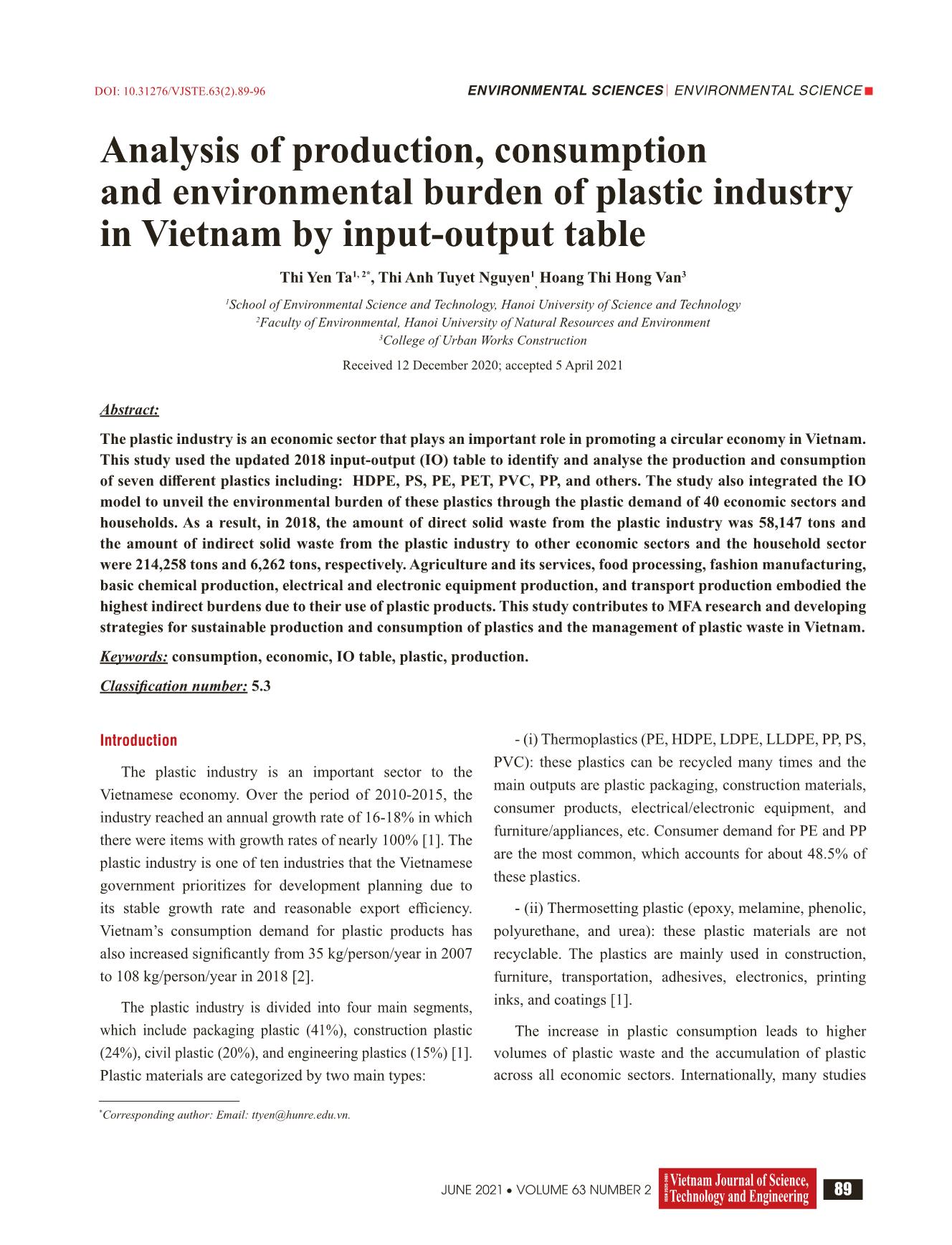
Trang 1
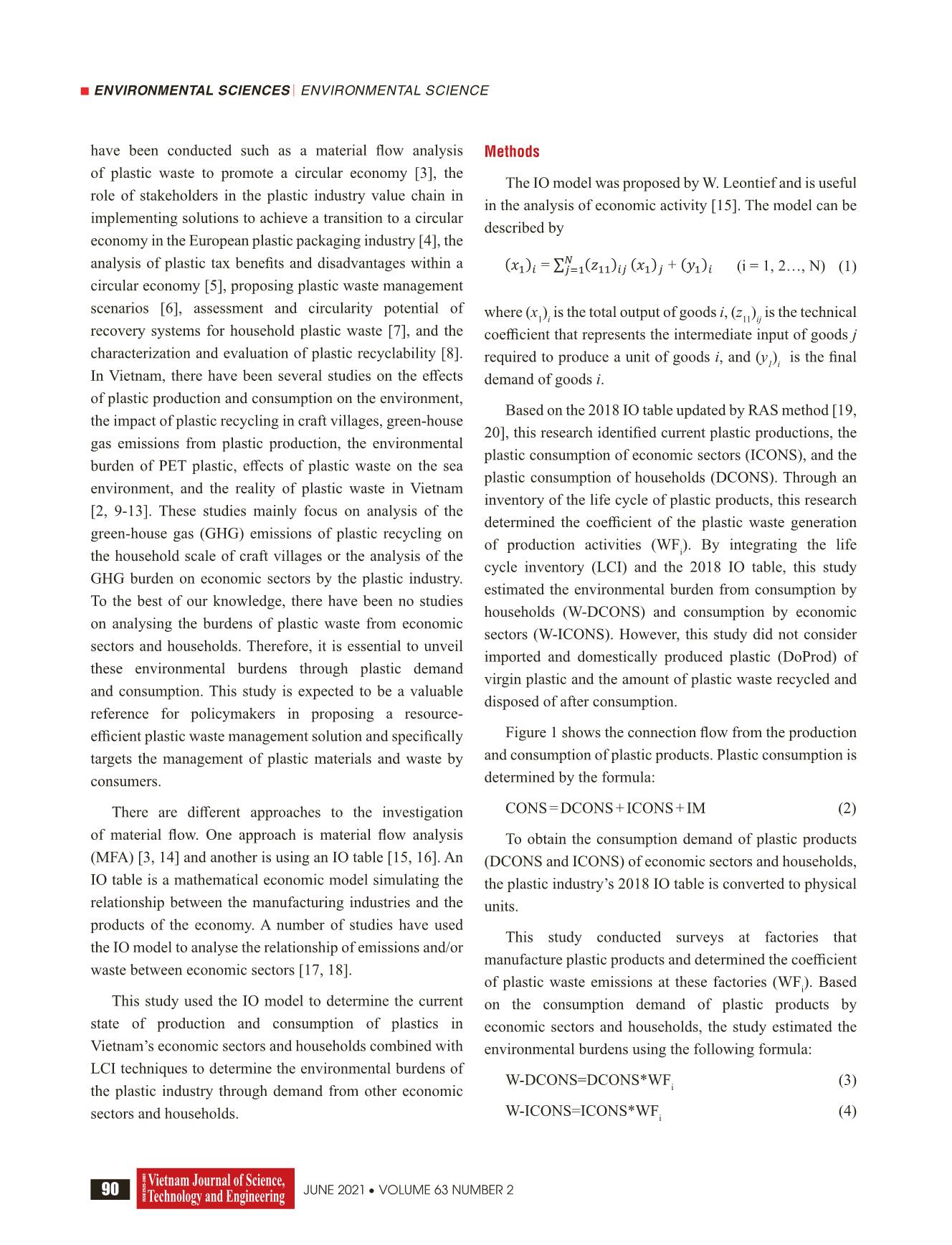
Trang 2
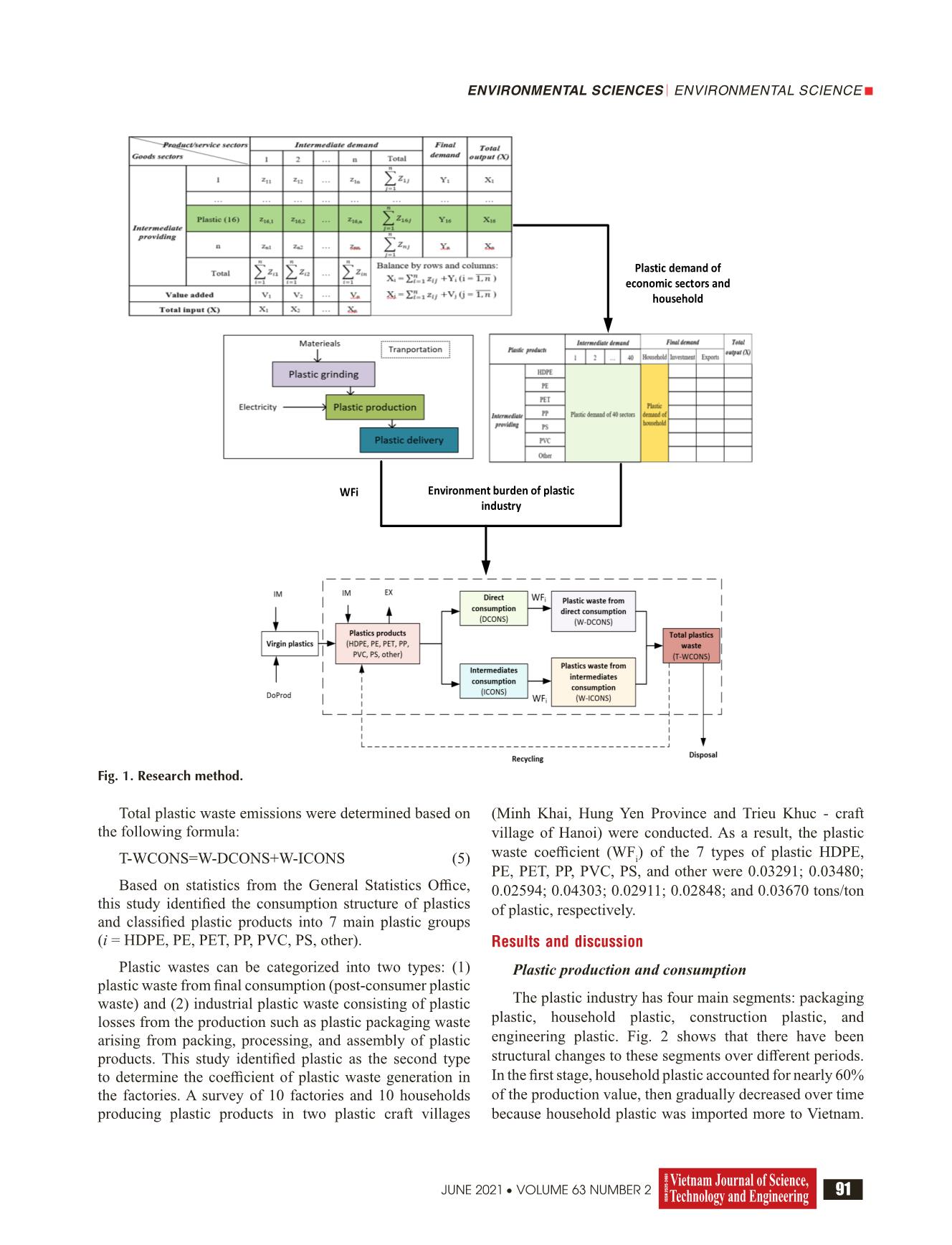
Trang 3
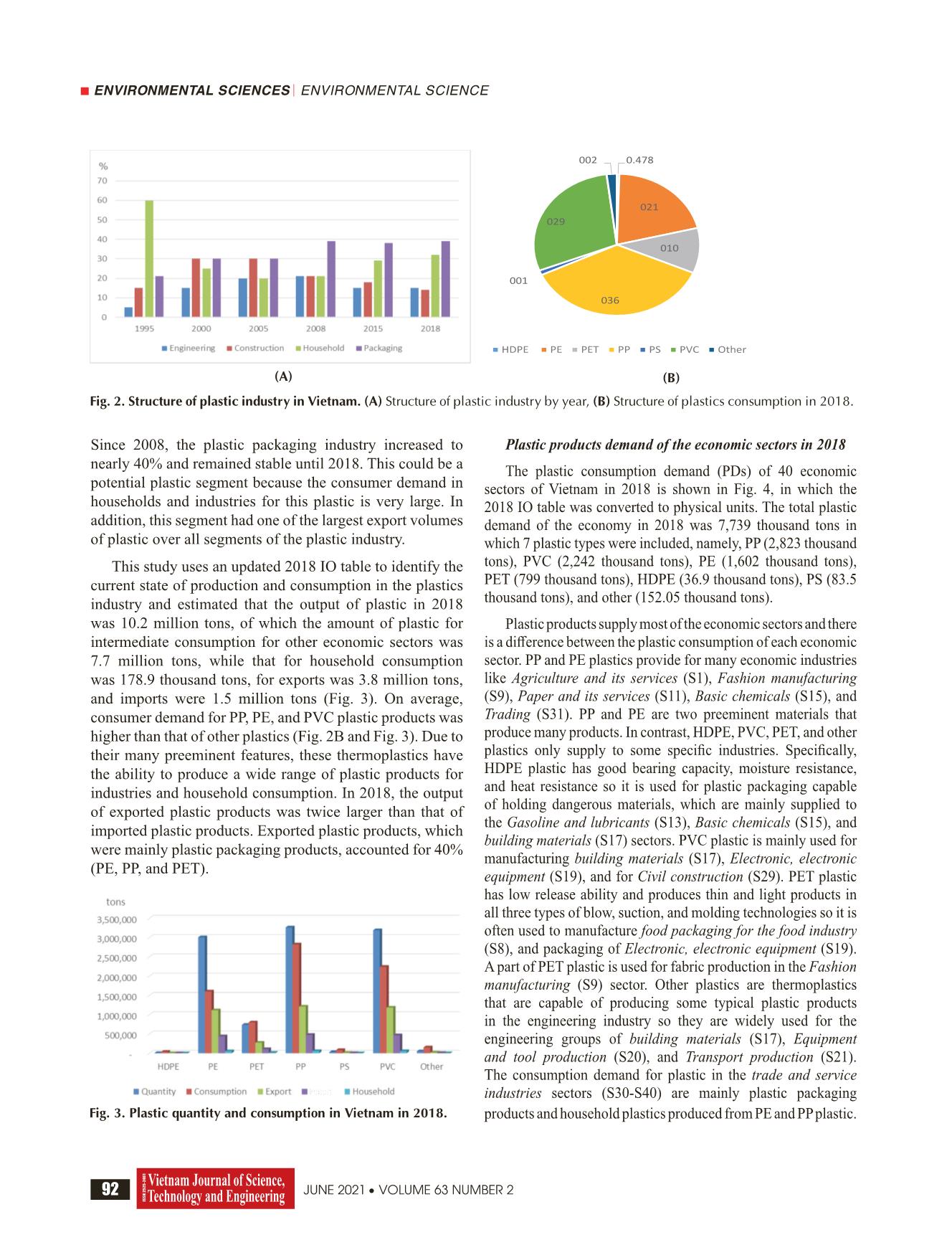
Trang 4
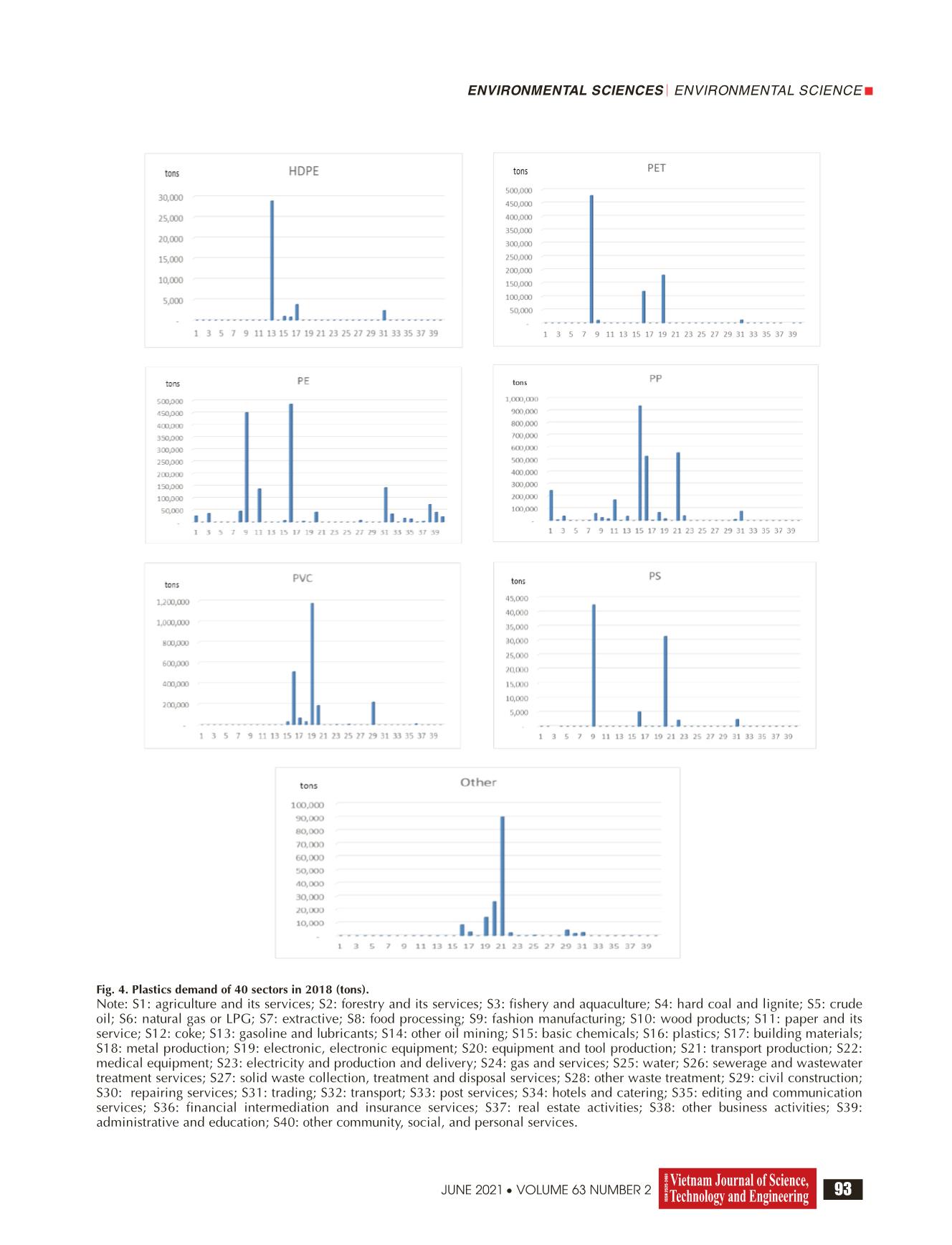
Trang 5
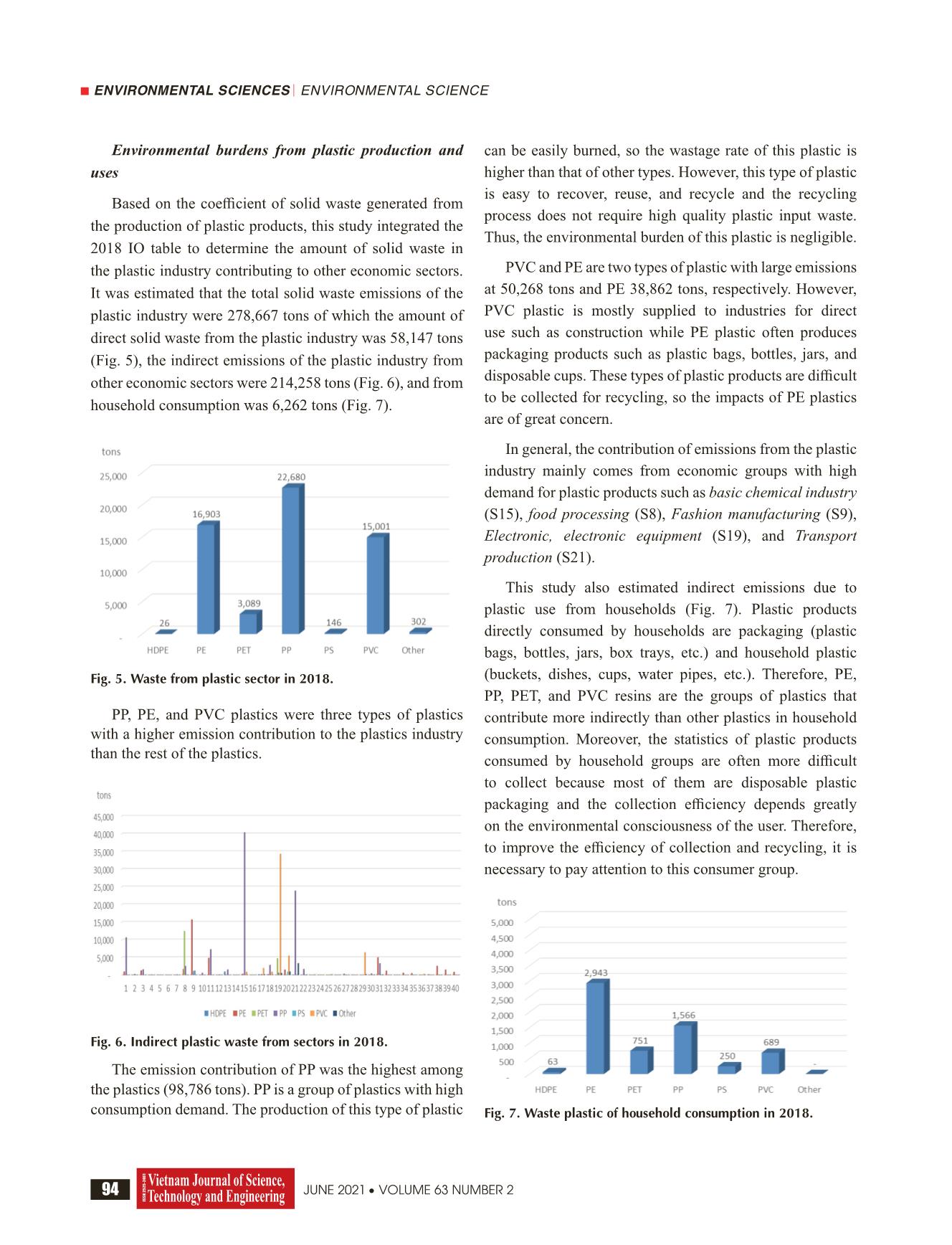
Trang 6
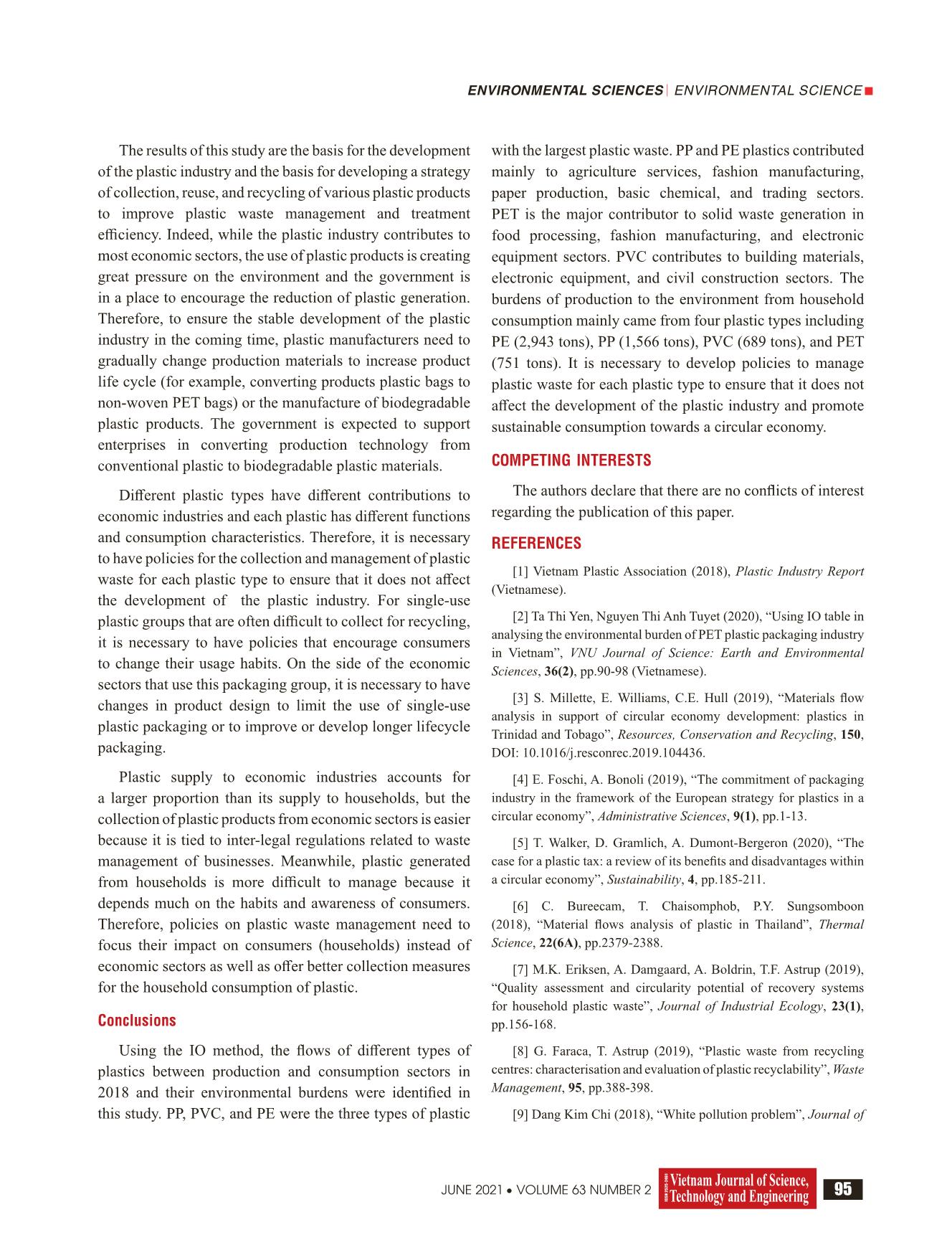
Trang 7
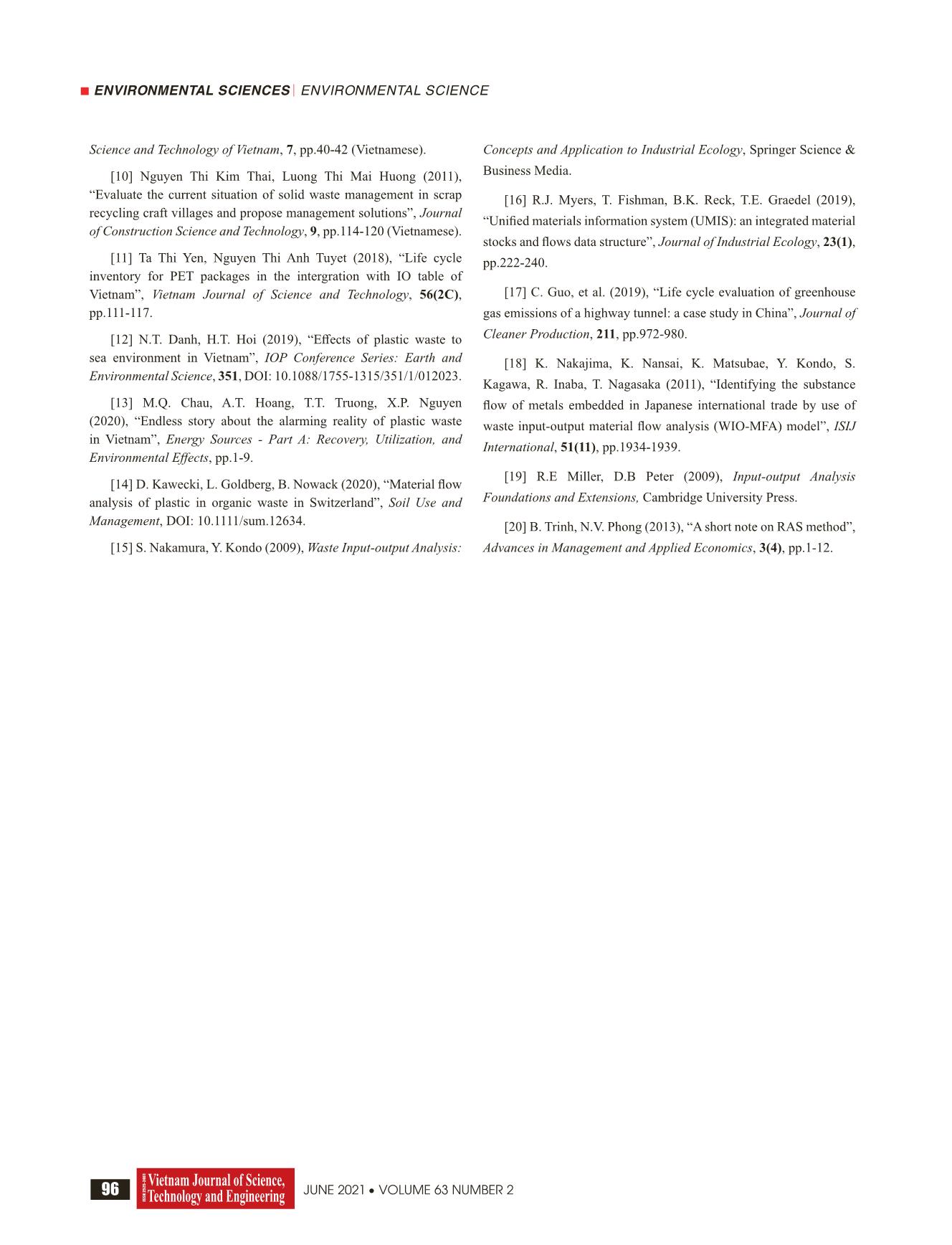
Trang 8
Tóm tắt nội dung tài liệu: Analysis of production, consumption and environmental burden of plastic industry in Vietnam by input-Output table
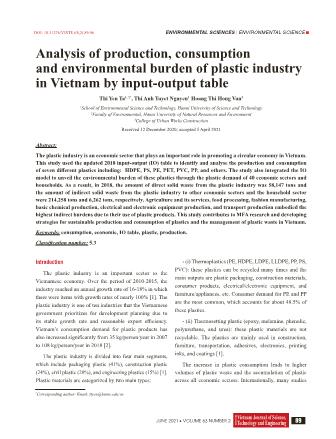
EnvironmEntal SciEncES | EnvironmEntal SciEncE Vietnam Journal of Science, Technology and Engineering 89June 2021 • Volume 63 number 2 Introduction The plastic industry is an important sector to the Vietnamese economy. Over the period of 2010-2015, the industry reached an annual growth rate of 16-18% in which there were items with growth rates of nearly 100% [1]. The plastic industry is one of ten industries that the Vietnamese government prioritizes for development planning due to its stable growth rate and reasonable export efficiency. Vietnam’s consumption demand for plastic products has also increased significantly from 35 kg/person/year in 2007 to 108 kg/person/year in 2018 [2]. The plastic industry is divided into four main segments, which include packaging plastic (41%), construction plastic (24%), civil plastic (20%), and engineering plastics (15%) [1]. Plastic materials are categorized by two main types: - (i) Thermoplastics (PE, HDPE, LDPE, LLDPE, PP, PS, PVC): these plastics can be recycled many times and the main outputs are plastic packaging, construction materials, consumer products, electrical/electronic equipment, and furniture/appliances, etc. Consumer demand for PE and PP are the most common, which accounts for about 48.5% of these plastics. - (ii) Thermosetting plastic (epoxy, melamine, phenolic, polyurethane, and urea): these plastic materials are not recyclable. The plastics are mainly used in construction, furniture, transportation, adhesives, electronics, printing inks, and coatings [1]. The increase in plastic consumption leads to higher volumes of plastic waste and the accumulation of plastic across all economic sectors. Internationally, many studies Analysis of production, consumption and environmental burden of plastic industry in Vietnam by input-output table Thi Yen Ta1, 2*, Thi Anh Tuyet Nguyen1, Hoang Thi Hong Van3 1School of Environmental Science and Technology, Hanoi University of Science and Technology 2Faculty of Environmental, Hanoi University of Natural Resources and Environment 3College of Urban Works Construction Received 12 December 2020; accepted 5 April 2021 *Corresponding author: Email: ttyen@hunre.edu.vn. Abstract: The plastic industry is an economic sector that plays an important role in promoting a circular economy in Vietnam. This study used the updated 2018 input-output (IO) table to identify and analyse the production and consumption of seven different plastics including: HDPE, PS, PE, PET, PVC, PP, and others. The study also integrated the IO model to unveil the environmental burden of these plastics through the plastic demand of 40 economic sectors and households. As a result, in 2018, the amount of direct solid waste from the plastic industry was 58,147 tons and the amount of indirect solid waste from the plastic industry to other economic sectors and the household sector were 214,258 tons and 6,262 tons, respectively. Agriculture and its services, food processing, fashion manufacturing, basic chemical production, electrical and electronic equipment production, and transport production embodied the highest indirect burdens due to their use of plastic products. This study contributes to MFA research and developing strategies for sustainable production and consumption of plastics and the management of plastic waste in Vietnam. Keywords: consumption, economic, IO table, plastic, production. Classification number: 5.3 DOI: 10.31276/VJSTE.63(2).89-96 EnvironmEntal SciEncES | EnvironmEntal SciEncE Vietnam Journal of Science, Technology and Engineering90 June 2021 • Volume 63 number 2 have been conducted such as a material flow analysis of plastic waste to promote a circular economy [3], the role of stakeholders in the plastic industry value chain in implementing solutions to achieve a transition to a circular economy in the European plastic packaging industry [4], the analysis of plastic tax benefits and disadvantages within a circular economy [5], proposing plastic waste management scenarios [6], assessment and circularity potential of recovery systems for household plastic waste [7], and the characterization and evaluation of plastic recyclability [8]. In Vietnam, there have been several studies on the effects of plastic production and consumption on the environment, the impact of plastic recycling in craft villages, green-house gas emissions from plastic production, the environmental burden of PET plastic, effects of plastic waste on the sea environment, and the reality of plastic waste in Vietnam [2, 9-13]. These studies mainly focus on analysis of the green-house gas (GHG) emissions of plastic recycling on the household scale of craft villages or the analysis of the GHG burden on economic sectors by the plastic industry. To the best of our knowledge, there have been no studies on analysing the burdens of plastic waste from economic sectors and households. Therefore, it is essential to unveil these environmental burdens through plastic demand and consumption. This study is expected to be a valuable reference for policymakers in proposing a resource- efficient plastic waste management solution and specifically targets the management of plastic materials and waste by consumers. There are different approaches to the investigation of material flow. One approach is material flow analysis (MFA) [3, 14] and another is using an IO table [15, 16]. An IO table is a mathematical economic model simulating the relationship between the manufacturing industries and the products of the economy. A number of studies have used the IO model to analyse the relationship of emissions and/or waste between economic sectors [17, 18]. This study used the IO model to determine the current state of production and consumption of plastics in Vietnam’s economic sectors and households combined with ... production (S20), and Transport production (S21). The consumption demand for plastic in the trade and service industries sectors (S30-S40) are mainly plastic packaging products and household plastics produced from PE and PP plastic. (A) 7 The plastic industry has four main segments: packaging plastic, household plastic, construction plastic, and engineering plastic. Figure 2 shows that there have been structural changes to these segments over different periods. In the first stage, household plastic accounted for nearly 60% of the production value, then gradually decreased over time because household plastic was imported more to Vietnam. Since 2008, the plastic packaging industry increased to nearly 40% and remained stable until 2018. This could be a potential plastic segment because the consumer demand in households and industries for this plastic is very large. In addition, this segment had one of the largest export volumes of plastic over all segments of the plastic industry. A) Structure of plastic industry by year B) Structure of plastics consumption in 2018 Fig. 2. Structure of plastic industry in Vietnam. This study uses an updated 2018 IO tabl to identify the curre t state f production and consumption in the plastics industry and estimated that the output of plastic in 2018 was 10.2 million tons, of which the a ount of plastic for intermediate consumption for other economic sectors was 7.7 million tons, while that for household consumption was 178.9 thousand tons, for exports was 3.8 0.478 021 010 036 001 029 002 HDPE PE PET PP PS PVC Other (B) Fig. 2. Structure of plastic industry in Vietnam. (A) Structure of plastic industry by year, (B) Structure of plastics consumption in 2018. Fig. 3. Plastic quantity and consumption in Vietnam in 2018. EnvironmEntal SciEncES | EnvironmEntal SciEncE Vietnam Journal of Science, Technology and Engineering 93June 2021 • Volume 63 number 2 Fig. 4. Plastics demand of 40 sectors in 2018 (tons). Note: S1: agriculture and its services; S2: forestry and its services; S3: fishery and aquaculture; S4: hard coal and lignite; S5: crude oil; S6: natural gas or lPG; S7: extractive; S8: food processing; S9: fashion manufacturing; S10: wood products; S11: paper and its service; S12: coke; S13: gasoline and lubricants; S14: other oil mining; S15: basic chemicals; S16: plastics; S17: building materials; S18: metal production; S19: electronic, electronic equipment; S20: equipment and tool production; S21: transport production; S22: medical equipment; S23: electricity and production and delivery; S24: gas and services; S25: water; S26: sewerage and wastewater treatment services; S27: solid waste collection, treatment and disposal services; S28: other waste treatment; S29: civil construction; S30: repairing services; S31: trading; S32: transport; S33: post services; S34: hotels and catering; S35: editing and communication services; S36: financial intermediation and insurance services; S37: real estate activities; S38: other business activities; S39: administrative and education; S40: other community, social, and personal services. EnvironmEntal SciEncES | EnvironmEntal SciEncE Vietnam Journal of Science, Technology and Engineering94 June 2021 • Volume 63 number 2 Environmental burdens from plastic production and uses Based on the coefficient of solid waste generated from the production of plastic products, this study integrated the 2018 IO table to determine the amount of solid waste in the plastic industry contributing to other economic sectors. It was estimated that the total solid waste emissions of the plastic industry were 278,667 tons of which the amount of direct solid waste from the plastic industry was 58,147 tons (Fig. 5), the indirect emissions of the plastic industry from other economic sectors were 214,258 tons (Fig. 6), and from household consumption was 6,262 tons (Fig. 7). Fig. 5. Waste from plastic sector in 2018. PP, PE, and PVC plastics were three types of plastics with a higher emission contribution to the plastics industry than the rest of the plastics. Fig. 6. Indirect plastic waste from sectors in 2018. The emission contribution of PP was the highest among the plastics (98,786 tons). PP is a group of plastics with high consumption demand. The production of this type of plastic can be easily burned, so the wastage rate of this plastic is higher than that of other types. However, this type of plastic is easy to recover, reuse, and recycle and the recycling process does not require high quality plastic input waste. Thus, the environmental burden of this plastic is negligible. PVC and PE are two types of plastic with large emissions at 50,268 tons and PE 38,862 tons, respectively. However, PVC plastic is mostly supplied to industries for direct use such as construction while PE plastic often produces packaging products such as plastic bags, bottles, jars, and disposable cups. These types of plastic products are difficult to be collected for recycling, so the impacts of PE plastics are of great concern. In general, the contribution of emissions from the plastic industry mainly comes from economic groups with high demand for plastic products such as basic chemical industry (S15), food processing (S8), Fashion manufacturing (S9), Electronic, electronic equipment (S19), and Transport production (S21). This study also estimated indirect emissions due to plastic use from households (Fig. 7). Plastic products directly consumed by households are packaging (plastic bags, bottles, jars, box trays, etc.) and household plastic (buckets, dishes, cups, water pipes, etc.). Therefore, PE, PP, PET, and PVC resins are the groups of plastics that contribute more indirectly than other plastics in household consumption. Moreover, the statistics of plastic products consumed by household groups are often more difficult to collect because most of them are disposable plastic packaging and the collection efficiency depends greatly on the environmental consciousness of the user. Therefore, to improve the efficiency of collection and recycling, it is necessary to pay attention to this consumer group. Fig. 7. Waste plastic of household consumption in 2018. EnvironmEntal SciEncES | EnvironmEntal SciEncE Vietnam Journal of Science, Technology and Engineering 95June 2021 • Volume 63 number 2 The results of this study are the basis for the development of the plastic industry and the basis for developing a strategy of collection, reuse, and recycling of various plastic products to improve plastic waste management and treatment efficiency. Indeed, while the plastic industry contributes to most economic sectors, the use of plastic products is creating great pressure on the environment and the government is in a place to encourage the reduction of plastic generation. Therefore, to ensure the stable development of the plastic industry in the coming time, plastic manufacturers need to gradually change production materials to increase product life cycle (for example, converting products plastic bags to non-woven PET bags) or the manufacture of biodegradable plastic products. The government is expected to support enterprises in converting production technology from conventional plastic to biodegradable plastic materials. Different plastic types have different contributions to economic industries and each plastic has different functions and consumption characteristics. Therefore, it is necessary to have policies for the collection and management of plastic waste for each plastic type to ensure that it does not affect the development of the plastic industry. For single-use plastic groups that are often difficult to collect for recycling, it is necessary to have policies that encourage consumers to change their usage habits. On the side of the economic sectors that use this packaging group, it is necessary to have changes in product design to limit the use of single-use plastic packaging or to improve or develop longer lifecycle packaging. Plastic supply to economic industries accounts for a larger proportion than its supply to households, but the collection of plastic products from economic sectors is easier because it is tied to inter-legal regulations related to waste management of businesses. Meanwhile, plastic generated from households is more difficult to manage because it depends much on the habits and awareness of consumers. Therefore, policies on plastic waste management need to focus their impact on consumers (households) instead of economic sectors as well as offer better collection measures for the household consumption of plastic. Conclusions Using the IO method, the flows of different types of plastics between production and consumption sectors in 2018 and their environmental burdens were identified in this study. PP, PVC, and PE were the three types of plastic with the largest plastic waste. PP and PE plastics contributed mainly to agriculture services, fashion manufacturing, paper production, basic chemical, and trading sectors. PET is the major contributor to solid waste generation in food processing, fashion manufacturing, and electronic equipment sectors. PVC contributes to building materials, electronic equipment, and civil construction sectors. The burdens of production to the environment from household consumption mainly came from four plastic types including PE (2,943 tons), PP (1,566 tons), PVC (689 tons), and PET (751 tons). It is necessary to develop policies to manage plastic waste for each plastic type to ensure that it does not affect the development of the plastic industry and promote sustainable consumption towards a circular economy. COMPETING INTERESTS The authors declare that there are no conflicts of interest regarding the publication of this paper. REFERENCES [1] Vietnam Plastic Association (2018), Plastic Industry Report (Vietnamese). [2] Ta Thi Yen, Nguyen Thi Anh Tuyet (2020), “Using IO table in analysing the environmental burden of PET plastic packaging industry in Vietnam”, VNU Journal of Science: Earth and Environmental Sciences, 36(2), pp.90-98 (Vietnamese). [3] S. Millette, E. Williams, C.E. Hull (2019), “Materials flow analysis in support of circular economy development: plastics in Trinidad and Tobago”, Resources, Conservation and Recycling, 150, DOI: 10.1016/j.resconrec.2019.104436. [4] E. Foschi, A. Bonoli (2019), “The commitment of packaging industry in the framework of the European strategy for plastics in a circular economy”, Administrative Sciences, 9(1), pp.1-13. [5] T. Walker, D. Gramlich, A. Dumont-Bergeron (2020), “The case for a plastic tax: a review of its benefits and disadvantages within a circular economy”, Sustainability, 4, pp.185-211. [6] C. Bureecam, T. Chaisomphob, P.Y. Sungsomboon (2018), “Material flows analysis of plastic in Thailand”, Thermal Science, 22(6A), pp.2379-2388. [7] M.K. Eriksen, A. Damgaard, A. Boldrin, T.F. Astrup (2019), “Quality assessment and circularity potential of recovery systems for household plastic waste”, Journal of Industrial Ecology, 23(1), pp.156-168. [8] G. Faraca, T. Astrup (2019), “Plastic waste from recycling centres: characterisation and evaluation of plastic recyclability”, Waste Management, 95, pp.388-398. [9] Dang Kim Chi (2018), “White pollution problem”, Journal of EnvironmEntal SciEncES | EnvironmEntal SciEncE Vietnam Journal of Science, Technology and Engineering96 June 2021 • Volume 63 number 2 Science and Technology of Vietnam, 7, pp.40-42 (Vietnamese). [10] Nguyen Thi Kim Thai, Luong Thi Mai Huong (2011), “Evaluate the current situation of solid waste management in scrap recycling craft villages and propose management solutions”, Journal of Construction Science and Technology, 9, pp.114-120 (Vietnamese). [11] Ta Thi Yen, Nguyen Thi Anh Tuyet (2018), “Life cycle inventory for PET packages in the intergration with IO table of Vietnam”, Vietnam Journal of Science and Technology, 56(2C), pp.111-117. [12] N.T. Danh, H.T. Hoi (2019), “Effects of plastic waste to sea environment in Vietnam”, IOP Conference Series: Earth and Environmental Science, 351, DOI: 10.1088/1755-1315/351/1/012023. [13] M.Q. Chau, A.T. Hoang, T.T. Truong, X.P. Nguyen (2020), “Endless story about the alarming reality of plastic waste in Vietnam”, Energy Sources - Part A: Recovery, Utilization, and Environmental Effects, pp.1-9. [14] D. Kawecki, L. Goldberg, B. Nowack (2020), “Material flow analysis of plastic in organic waste in Switzerland”, Soil Use and Management, DOI: 10.1111/sum.12634. [15] S. Nakamura, Y. Kondo (2009), Waste Input-output Analysis: Concepts and Application to Industrial Ecology, Springer Science & Business Media. [16] R.J. Myers, T. Fishman, B.K. Reck, T.E. Graedel (2019), “Unified materials information system (UMIS): an integrated material stocks and flows data structure”, Journal of Industrial Ecology, 23(1), pp.222-240. [17] C. Guo, et al. (2019), “Life cycle evaluation of greenhouse gas emissions of a highway tunnel: a case study in China”, Journal of Cleaner Production, 211, pp.972-980. [18] K. Nakajima, K. Nansai, K. Matsubae, Y. Kondo, S. Kagawa, R. Inaba, T. Nagasaka (2011), “Identifying the substance flow of metals embedded in Japanese international trade by use of waste input-output material flow analysis (WIO-MFA) model”, ISIJ International, 51(11), pp.1934-1939. [19] R.E Miller, D.B Peter (2009), Input-output Analysis Foundations and Extensions, Cambridge University Press. [20] B. Trinh, N.V. Phong (2013), “A short note on RAS method”, Advances in Management and Applied Economics, 3(4), pp.1-12.
File đính kèm:
 analysis_of_production_consumption_and_environmental_burden.pdf
analysis_of_production_consumption_and_environmental_burden.pdf

